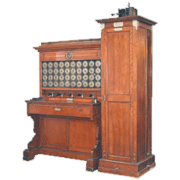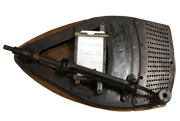Japan promulgated the National Census Law in 1902. Thinking that a statistics machine was necessary to efficiently tabulate the census results, the government decided to develop such a machine domestically and asked, via the Cabinet, the Ministry of Communications and Transportation to do so. Kawaguchi Ichitaro, an engineer at the Ministry’s telegraph signal factory, started researching and developing the machine. A prototype was finished in 1905 to tabulate some of the results of the 1904 Demographics Statistical Study.
The machine consisted of a sorter (shown on the right side of the photo below) and a measuring bench (shown on the left). The machine sorts and tabulates input data by connecting the two parts together. The sorter consisted of a sort box (a long box that held the cards to be sorted) and a connector that was fixed to the top of the box. The measuring bench was constructed with gauges (40 clock-like gauges each with one long hand and one short hand) and five handles below the gauges.
The input tiles, or cards, made with a tortoise-shell keypunch, were loaded in the inserter at the top of the sorter. By turning the handles, sorter pins (a supply pin and a receiver pin) would contact through the cards perforations, allowing current to flow. This current moved the long hand one increment (counting one card) in one of the measuring bench’s gauges. The long and short hands were calibrated so that one full rotation of the long hand counted 100 cards and one full rotation of the short hand counted 10,000 cards. The hands returned to zero after completing one rotation. Thus, the number of cards punched for each survey category could be read from the gauges.
The prototype is now kept at the Statistical Museum and is exhibited along with other tabulation devices.



